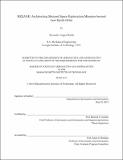HEXANE : architecting manned space exploration missions beyond low-earth orbit
Author(s)
Rudat, Alexander August
DownloadFull printable version (7.916Mb)
Alternative title
Architecting manned space exploration missions beyond low-earth orbit
Other Contributors
Massachusetts Institute of Technology. Department of Aeronautics and Astronautics.
Advisor
Edward F. Crawley.
Terms of use
Metadata
Show full item recordAbstract
With the end of the Space Shuttle Program and the cancellation of the Constellation Program, NASA's long-term designs for manned spaceflight beyond Earth orbit remain indefinite. Although progress has been made in plans for operations on orbit, the capabilities gap for manned spaceflight beyond orbit has grown. Gaining an understanding of the trade-offs inherent in future system architectures for manned missions aids decision support for long-term planning of the spaceflight infrastructure. Assessments of such manned missions are particularly difficult due to the quantity of applicable technologies and potential component, sub-system, and system-level elements. Complex interactions between these technologies and elements lead to the need for high-fidelity analysis, requiring significant resource investments. NASA has typically turned to expert opinion and detailed point design studies to assess possible mission architectures, but recent developments in the field of systems architecture and computer science allow for the assessment of these architectures through system modeling techniques. This thesis presents a tool for the enumeration and analysis of system architectures for future manned missions to the Moon, Mars, and Near-Earth Asteroids (NEAs). An abstracted, solution-neutral formulation of the system allows for the analysis of the in-space transportation infrastructure portion of potential mission architectures through a unique functional decomposition and use of a decision formulation. Cost-based metrics are derived for the evaluation of architectures, representing both mass-based operations costs as well as development and procurement costs. The full combinatorial enumeration of the architecture tradespace generates a large data set on which to perform analysis. Rigorous techniques are used to derive decision influence information from this data. In-depth evaluation of Mars conjunction-class missions, with an emphasis on the assessment of highly influential architectural decisions, is presented, along with a more superficial treatment of lunar and NEA architectures. Mission architectures to these destinations are likely to require many new technologies and large-scale mission elements. In order to build confidence in these technologies and elements, precursor demonstration sub-missions (missions performed prior to the final surface mission) are often required. A tool is presented to leverage the results from the mission enumeration and evaluation model, exploring the tradespace of demonstration sub-mission sequences. In particular, this tool analyzes the grouping of technologies and mission elements to demonstrate. It also examines the use of Lagrange points as destinations for precursor sub-missions. Results from this tool are presented for lunar and low-energy NEA missions using metrics representing both individual sub-mission properties as well as sequence-level properties. Finally, a framework is presented for the construction of architecture-level complex system models. The development of this framework is based in knowledge gained from building the previously described tools as well as an academic background in system architecting. The framework directs professionals and academics in the process of designing complex system models with the intent of reducing gratuitous and modeling-induced complexity while retaining essential complexity. A brief case study is used to demonstrate the benefits gained from the use of the framework in comparison to unguided model creation.
Description
Thesis (S.M.)--Massachusetts Institute of Technology, Dept. of Aeronautics and Astronautics, 2013. This electronic version was submitted and approved by the author's academic department as part of an electronic thesis pilot project. The certified thesis is available in the Institute Archives and Special Collections. Cataloged from department-submitted PDF version of thesis Includes bibliographical references (p. 203-211).
Date issued
2013Department
Massachusetts Institute of Technology. Department of Aeronautics and AstronauticsPublisher
Massachusetts Institute of Technology
Keywords
Aeronautics and Astronautics.